Sydney Town Hall
| Sydney Town Hall | |
|---|---|
 | |
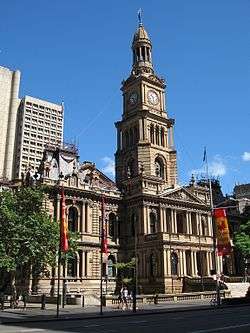 The Town Hall, pictured in 2006. | |
| Alternative names | Town Hall, Centennial Hall, Main Hall, Peace Hall, Great Hall, Old Burial Ground |
| General information | |
| Status | Complete |
| Type | Town hall |
| Architectural style | |
| Location | 483 George Street, Sydney CBD, New South Wales |
| Country | Australia |
| Coordinates | 33°52′24″S 151°12′23″E / 33.873235°S 151.206323°ECoordinates: 33°52′24″S 151°12′23″E / 33.873235°S 151.206323°E |
| Construction started | 1886 |
| Opened | 1889 |
| Renovated | 1991-92 |
| Renovation cost | A$15.5 million |
| Owner | Council of the City of Sydney |
| Technical details | |
| Material |
|
| Floor count | 2 |
| Lifts/elevators | 1 |
| Design and construction | |
| Architect | John H. Wilson |
| Other designers |
|
| Main contractor |
|
| Known for |
|
| Other information | |
| Seating capacity | 2,535 (Centennial Hall) |
| Website | |
|
www | |
| Official name | Sydney Town Hall |
| Type | Built |
| Criteria | a., b., c., d., e., f., g. |
| Designated | 5 March 2010 |
| Part of | Town Hall / QVB Group |
| Reference no. | 01452 |
| [1][2][3] | |
The Sydney Town Hall is a late 19th-century building in the city of Sydney, the capital city of New South Wales, Australia, housing the chambers of the Lord Mayor of Sydney, council offices, and venues for meetings and functions. It is located on George Street, in the Sydney central business district opposite the Queen Victoria Building and alongside St Andrew's Cathedral. Sited above the Town Hall station and between the city shopping and entertainment precincts, the steps of the Town Hall are a popular meeting place.
The Town Hall is listed on the (now defunct) Register of the National Estate[1] and the New South Wales State Heritage Register[2] and is part of the heritage-listed Town Hall precinct which includes the Queen Victoria Building, St Andrew's Cathedral, the Gresham Hotel and the former Bank of New South Wales.[4]
History and description
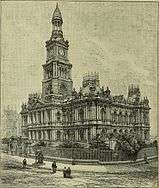
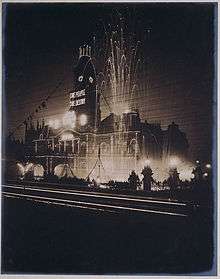
The Town Hall was built in the 1880s – on the site of the former Old Sydney Burial Ground. The cemetery was Sydney's first permanent cemetery and it is estimated that at least 2000 burials were made in the Old Sydney Burial Ground between 1782 and 1820.[3]
The Town Hall was built from local Sydney sandstone in the grand Victorian Second Empire style,[1] inspired by the French Second Empire Hotel de Ville in Paris.[3] The Town Hall has been described as having "lavishly ornamented composition with focal tower and fanciful roofs".[5] The building consists of the original Town Hall, mayoral suites and town clerk's offices. These were designed by J. H. Wilson in 1866, having won a civic competition to design a town hall for the rapidly-growing city. Construction of his initial designs were completed under the architectural direction of Albert Bond in 1869.[6] Wilson also designed the interior of the original Town Hall meeting room. The clock tower was completed in 1873[6] to the design of E. and T. Bradbridge and whose clock was installed in 1884. The Centennial Hall and associated offices and entrances were designed by Thomas H. Sapsford in 1883,[6] but after his death were completed by architects David McBeath, John Hennessy and George McRae in 1889.[1]
The building houses the Sydney City Council Chamber, reception rooms, the Centennial Hall and offices for the Lord Mayor and elected councillors.
The Centennial Hall contains the Grand Organ, the world's largest pipe organ with tubular pneumatic action, built from 1886 to 1889 and installed in 1890 by the English firm of William Hill & Son. The organ possesses one of only two full-length 64′ organ stops in the world (the Contra-Trombone in the pedal). Before the opening of the Sydney Opera House and its Concert Hall, the Town Hall was Sydney's premier concert hall, and many notable performances took place there.
In the later years, it has been discovered that Town Hall lies on top of part of a cemetery complex. Renovations were undertaken in 2008-9 primarily to upgrade the mechanical, hydraulic, electrical and communication services within the building. The renovations, completed by Sydney builder Kell & Rigby, included removing 6,000 cubic metres (210,000 cu ft) of sandstone from underneath the building.[7]
Statement of significance
Listed on the State Heritage Register on 5 March 2010, the building was given the following statement of significance:[2]
Sydney Town Hall is significant for its continuing use as the offices of the Council of the City of Sydney and as the city's civic and cultural centre. It is the centre of city politics and the place where decisions are made about the city. Major civic events are celebrated here and the hall acts as the venue for major cultural events, benefit concerts and rituals. It has high social value for all sections of the community and is used regularly as the meeting place for political protests and rallies.
The building with its clock tower and steps is a city landmark and symbol of the city, both historically and today. It is the most elaborate and exuberant work of Second Empire Style architecture in Australia featuring corner towers, domed pavilions, pedimented breakfront entries, a hierarchy of decorative orders, columned and pedimented window treatment, venetian windows and elaborate decoration. It exhibits the highest level of craftsmanship, quality of materials and incorporates technological advances. Elaborate interiors exhibit fine design and craftsmanship.
Decorative features of exceptional significance include the vestibule glass dome, the organ, mosaic floors, carved cedar joinery and carved sandstone and marble. It features the first known use of Australian motifs in the etched glass. Exceptional windows by Lucien Henry also feature Australian flora.
The growth of the building reflects the growth and importance of the city. The development of the city coat of arms is also recorded in the building fabric.
The site and surrounding land has high historical and archaeological importance as it represents the location of the former Old Sydney Burial Ground. The cemetery was Sydney's first permanent cemetery, set out in September 1782 by Governor Phillip and the Reverend Richard Johnson. It was closed in 1820 when the Sandhills or Brickfield cemetery was opened. Works within Town Hall and its vicinity regularly expose remains of graves.
As an archaeological resource, Old Sydney Burial Ground has high scientific research potential as it contains material culture related to a seminal phase of the nation's history. As a burial ground which includes remains of some of the city's founding pioneers and one of Sydney's oldest European religious and ceremonial sites, the Old Sydney Burial Ground has outstanding social value to the people of Sydney and Australia. The Old Sydney Burial Ground is a site of State heritage significance.
The place is associated with many important people including politicians, designers, artists as well as performers and community figures and names are recorded in the fabric. There are important associated collections of records and of items such as art works which enhance understanding of the place and research and educational value.
— Statement of significance, New South Wales State Heritage Register.
Present day
The Sydney Town Hall still serves as an important presence and meeting place for the city of Sydney to this very day. The building itself regularly undergoes cleaning and restoration to preserve it for future generations. Additionally, it has been rendered with sustainability by improving energy efficiency, including smart light sensors, energy efficient lighting, new roofing insulation to moderate building temperature, solar panels, and new hydraulics and storm water infrastructure.[8]
Gallery
 The Centennial Hall with the grand organ
The Centennial Hall with the grand organ The domed ceiling
The domed ceiling Detail on one of the mansards
Detail on one of the mansards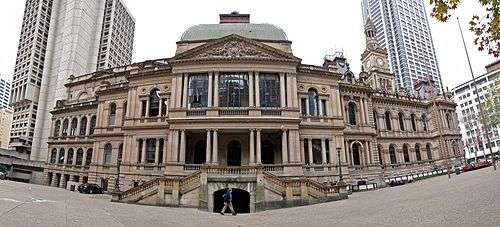 South side of building
South side of building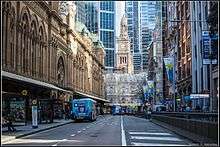 Queen Victoria Building and Sydney Town Hall undergoing maintenance viewed from York St, August 2014
Queen Victoria Building and Sydney Town Hall undergoing maintenance viewed from York St, August 2014- Centennial Hall during state memorial service for Gough Whitlam
Sydney_Town_Hall_025.jpg) Sandstone lion on north side of building
Sandstone lion on north side of building Sydney Town Hall as it appeared in the early 1900s facing north with St. Andrew's Cathedral to the left
Sydney Town Hall as it appeared in the early 1900s facing north with St. Andrew's Cathedral to the left
See also
References
- 1 2 3 4 "Sydney Town Hall (Place ID 1904)". Australian Heritage Database. Department of the Environment. 21 March 1978. Retrieved 23 September 2016.
- 1 2 3 "Sydney Town Hall". New South Wales State Heritage Register. Office of Environment and Heritage. Retrieved 24 September 2017.
- 1 2 3 "The site". Sydney Town Hall: Building history: Discover & learn. City of Sydney. 2016. Retrieved 24 September 2016.
- ↑ The Heritage of Australia. Macmillan Company. 1981. pp. 2, 100.
- ↑ A Pictorial Guide to Identifying Australian Architecture. Apperley. Angus and Robertson. 1994. p. 68.
- 1 2 3 "Construction". Sydney Town Hall: Building history: Discover & learn. City of Sydney. 2016. Retrieved 24 September 2016.
- ↑ "Old Sydney Burial Ground – City of Sydney". City of Sydney. February 2008.
- ↑ "City of Sydney: Sydney Town Hall". Retrieved 9 August 2015.
Attribution
![]()
External links
| Wikimedia Commons has media related to Sydney Town Hall. |